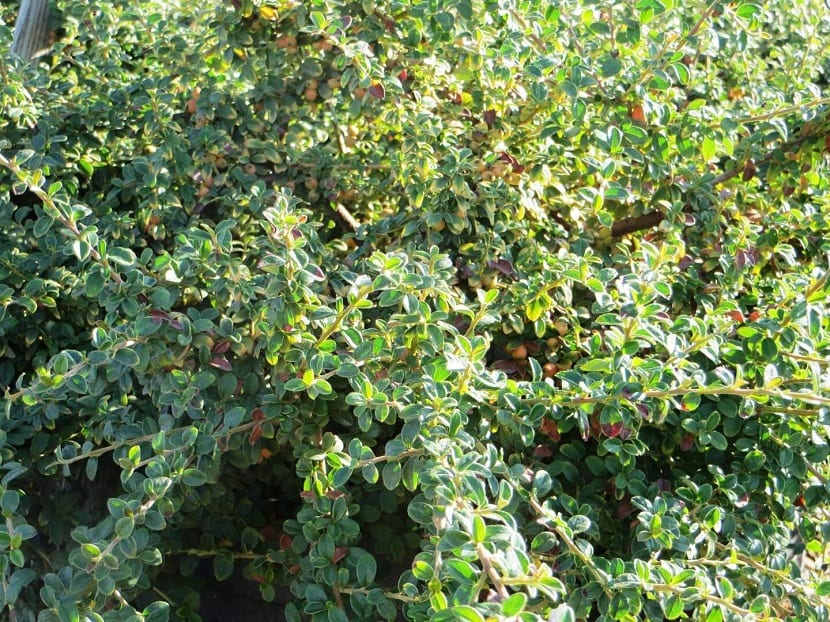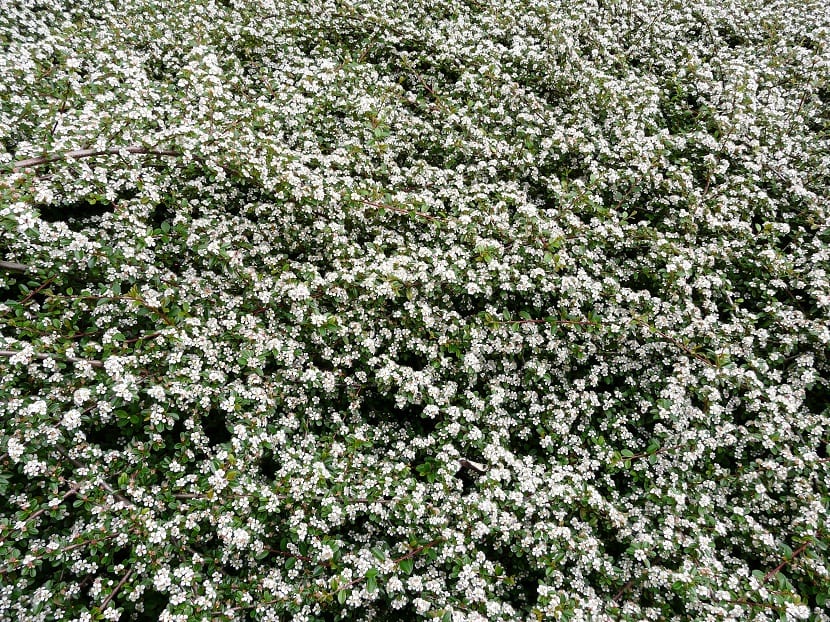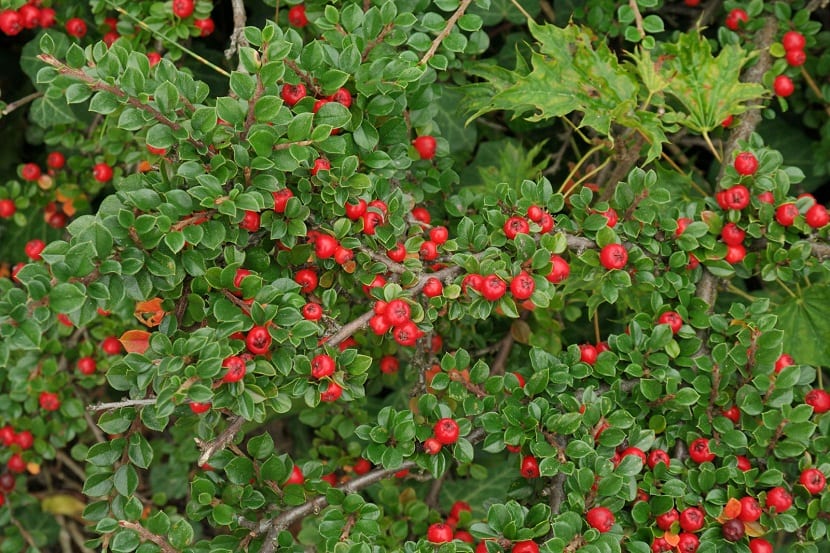
El Cotoneaster dammeri is a creeping shrub with soft branches belonging to the Rosaceae family. Its name derives from the Latin "cotoneum"Which means quince and"aster”Which means similar. It is commonly used in gardens for its small size and vigorous growth, particularly as a ground cover.
Originally from the mountainous regions, cliffs, mixed forests and rocky soils from China and the Himalayas, over the centuries it has spread widely throughout the European continent and in many areas of the Far East.
Features Cotoneaster dammeri
This is a low-maintenance shrub that adapts to all types of soils, even the most difficult ones. This species spreads rapidly as a consequence of its characteristic natural stratification.
El Cotoneaster dammeri It is a fairly small shrub with a wide diameter; its stems are long and creeping, which causes it to form dense layers that range from 20 to 60 centimeters high in a significant area of soil. As is known, its growth is rapid. Its widely branched branches are slender but stiff and covered with small densely established alternate evergreen leaves. Its foliage is persistent, with thick, oval leaves, leathery, glossy dark green on the upper surface and light on the underside, 2 to 3 centimeters long.
Flowering occurs at the end of May and lasts until September. Of small white flowers adorned with purple stamens, they have 5 petals that make them excellent flowers to decorate spaces, thanks to their large number and distribution throughout their various branches. In addition, this shrub makes it systematically pollinated by insects.
The berries are spherical and contain 5 seeds insideThey are of a very bright intense red color. Their maturation occurs between the months of September and October, they are used by the birds that feed on them, which makes them an element of interest for the biodiversity of the gardens. Very robust, it tolerates cold, urban pollution and wind very well. It grows in practically all types of soil, but prefers those that are slightly acidic with limestone, dry and consistent, which retain their freshness and richness in nutrients necessary for their growth.
Cultivation and propagation
It is a excellent alternative to obtain carpet in difficult terrain, thanks to the fact that it does not require maintenance or special care, except for disease prevention. To ensure better growth, sunny exposure or partial shade is recommended in any type of well-draining soil.
Its exposure to the shade negatively affects both its flowering and foliage. Therefore, if the intention is to create a carpet it is important to remember that the shade is detrimental to the plant. In addition, the definitive position of the plant is needed from the beginning of its planting, since the fact that its roots are not strong, makes its possible transplantation difficult.
It is preferable to plant from October to April, only one plant per pot, this because its root system is scarce. The Cotoneaster dammeri Irrigation demand during the summer season to stimulate the growth of its roots, so that it develops correctly. Its extensive branches can be rooted from an object to cover the walls.
It is necessary to maintain a distance of approximately 60 or 100 centimeters between them. Yes OK it is a fairly resistant plantIt does not tolerate long droughts and particularly during its growth period. To prevent it from losing the vegetation at its base as a consequence of its growth on the sides, it is advisable to carry out a moderate pruning annually. Usually the pruning of these shrubs is carried out to achieve their symmetry, so it is necessary to remove excess branches and dead ones. Pruning should be done in early spring to stimulate new branch growth, and this shrub requires fertilizers to maximize its potential, especially during spring and summer.
Specialists advise apply fertilizers with peat and manure, preparing a blanket of approximately 8 centimeters of soil. For better shrub growth it is feasible to use slow-release granular fertilizers containing potassium and phosphorus. It is characteristic of the plant that once its development period is over, it acquires excellent autonomy as regards water.
Diseases and parasites
Mealybugs
When the presence of brown spots on the leaves of this shrub is observed, it may be a sign that it has been attacked by mealybugs, which can be brown or mealy mealybug. They can be removed manually or with the use of specific pesticides available in specialized stores.
Fire blight
It is produced by the bacteria Erwinia amylovora. It is an infectious disease that spreads easily between plants. Until now, it is unknown how to cure the plant of such a disease, so there is nothing left but to cut the infected parts to shovel the attack of the bacteria a bit and burn them to prevent their possible spread.
Generally, the infection spreads from the upper part of the branches and is dangerously revealed in the young branches in favorable climatic conditions for its appearance, especially in the months of May to September. Some strong prophylactic measures such as disinfection of tools used in pruning diseased plants should also be applied. The symptoms of this terrible disease are; appearance of reddish spots on the leaves which later turn a brown color, then the leaves take a yellowish color and finally fall.
Aphids
Aphids can also attack the plant, these are some whitish and yellowish insects that feed on the leaves. They can also be combated with the use of specific pesticides. In the nurseries the species can suffer the gall attack transmitted by the Agrobacterium tumyfaciens. Be alert to the possible appearance of small tumors on stem and roots. It is also susceptible to attack by so-called defoliating caterpillars.
Uses
It is commonly used in gardens to create colorful hedges of different shapes, its arrangement indeed lends itself well to this purpose, giving gardens and villas great aesthetic value. In addition to being an excellent plant for preparing vegetable carpets even in the most difficult soils, its deep root system also makes it a good stabilizer of slopes and slopes.
Su abundant honey-producing bloom, makes it attractive to pollinating insects, butterflies and bees. The berries that follow the flowers in early September are eaten by birds.


